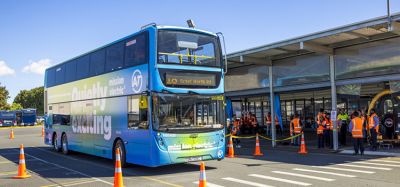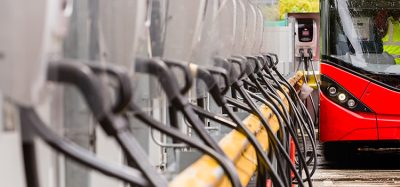Increasing the public transport offering for a growing city
- Like
- Digg
- Del
- Tumblr
- VKontakte
- Buffer
- Love This
- Odnoklassniki
- Meneame
- Blogger
- Amazon
- Yahoo Mail
- Gmail
- AOL
- Newsvine
- HackerNews
- Evernote
- MySpace
- Mail.ru
- Viadeo
- Line
- Comments
- Yummly
- SMS
- Viber
- Telegram
- Subscribe
- Skype
- Facebook Messenger
- Kakao
- LiveJournal
- Yammer
- Edgar
- Fintel
- Mix
- Instapaper
- Copy Link
Posted: 11 November 2013 | Michel Joye, Director, Transports publics de la région lausannoise SA (tl) | No comments yet
Lausanne – the capital of the canton of Vaud situated in the heart of Europe on the shores of Lake Geneva – is home to the headquarters of the International Olympic Committee, the Swiss Federal Institute of Technology (EPFL), the IMD and the Béjart Ballet, which together with other leading organisations underpin the city’s international reputation. In the world of public transport, it is also regularly in the spotlight for being the smallest city in the world to have an automatic driverless metro. Operated by Transports publics de la région lausannoise SA (tl), the m2 metro, inaugurated in 2008, has profoundly changed the face of the built-up area and transformed the mobility of an entire population. It has also proved at an international level that a city of fewer than one million inhabitants can justifiably claim ownership of such a transport system.
A veritable mountain railway climbing gradients of up to 12%, the m2 is the first metro of its kind in Switzerland. Covering differences in gradient of over 1,000 feet in less than 20 minutes, it has made its mark as an ideal solution for transporting a rapidly growing population very quickly, comfortably and safely. After four years in service, the m2 has already carried more than 100 million passengers in a population of around 300,000. Its success has paved the way for other major public transport developments which are now in the pipeline for Lausanne and its suburbs.
Lausanne – the capital of the canton of Vaud situated in the heart of Europe on the shores of Lake Geneva – is home to the headquarters of the International Olympic Committee, the Swiss Federal Institute of Technology (EPFL), the IMD and the Béjart Ballet, which together with other leading organisations underpin the city’s international reputation. In the world of public transport, it is also regularly in the spotlight for being the smallest city in the world to have an automatic driverless metro. Operated by Transports publics de la région lausannoise SA (tl), the m2 metro, inaugurated in 2008, has profoundly changed the face of the built-up area and transformed the mobility of an entire population. It has also proved at an international level that a city of fewer than one million inhabitants can justifiably claim ownership of such a transport system. A veritable mountain railway climbing gradients of up to 12%, the m2 is the first metro of its kind in Switzerland. Covering differences in gradient of over 1,000 feet in less than 20 minutes, it has made its mark as an ideal solution for transporting a rapidly growing population very quickly, comfortably and safely. After four years in service, the m2 has already carried more than 100 million passengers in a population of around 300,000. Its success has paved the way for other major public transport developments which are now in the pipeline for Lausanne and its suburbs.
Lausanne – the capital of the canton of Vaud situated in the heart of Europe on the shores of Lake Geneva – is home to the headquarters of the International Olympic Committee, the Swiss Federal Institute of Technology (EPFL), the IMD and the Béjart Ballet, which together with other leading organisations underpin the city’s international reputation. In the world of public transport, it is also regularly in the spotlight for being the smallest city in the world to have an automatic driverless metro. Operated by Transports publics de la région lausannoise SA (tl), the m2 metro, inaugurated in 2008, has profoundly changed the face of the built-up area and transformed the mobility of an entire population. It has also proved at an international level that a city of fewer than one million inhabitants can justifiably claim ownership of such a transport system.
A veritable mountain railway climbing gradients of up to 12%, the m2 is the first metro of its kind in Switzerland. Covering differences in gradient of over 1,000 feet in less than 20 minutes, it has made its mark as an ideal solution for transporting a rapidly growing population very quickly, comfortably and safely. After four years in service, the m2 has already carried more than 100 million passengers in a population of around 300,000. Its success has paved the way for other major public transport developments which are now in the pipeline for Lausanne and its suburbs.
Abandonment of the tram in the 1960s
Breaking the mould in 2008 when it opened the m2, tl has been a pioneer throughout its history. The company was founded in 1876 by a visionary, Adrien Palaz, an engineer with a passion for electricity who initiated and inaugurated Lausanne’s first ever tram network. Because of its undulating topography – the city centre is built on three hills linked by three essential bridges that form unavoidable main thoroughfares – the configuration of Lausanne was hardly conducive to running a network of tram cars. tl therefore gradually abandoned this mode of transport in favour of the trolleybus – both faster and more profitable. Another benefit noted at the time was that the vehicles run almost silently, without jolts or fumes. Thus in 1932, tl was once again a trailblazer when it opened Switzerland’s first trolleybus line between Port d’Ouchy and the station, which quickly proved its popularity. In the 1960s, with the explosion of the motor car, tl abandoned the tram network once and for all and continued to promote electric traction. A fleet of buses was added to the existing park of trolleybuses.
The m1 – the first successful metro
It was in 1991 that tl became a multi-modal railroad transport operator, inaugurating its first railway line – the m1. From Lausanne city centre, this high-performance route serves the University campus in the west, comprising the University of Lausanne and the EPFL. The international renown of these centres of learning has contributed to the increasing number of passengers catered for by the metro (more than 12 million passengers carried in 2012).
The m1 is a ‘light metro’. It is not a tram because it operates out of sight. Nor is it a metro in the strict sense, because it has level crossings. Operating during the rush hour at five-minute intervals, it remains today an international benchmark in terms of performance. Lausanne’s two metros have to cope with increasing passenger numbers. Today, the challenge is to increase their capacity.
tl – train constructors
The m1 metro currently has 17 railcars. After 20 years in operation, they are at present undergoing an overhaul – our maintenance teams are currently responsible for modernising equipment (doors, driver’s console, traction system, facilities for the disabled) to ensure the reliability of the system and guarantee comfort and quality of service for customers. However, we are going further and have accepted the challenge of building five additional vehicles internally which will supplement the existing fleet. With these five trains, the line’s maximum capacity will be able to be attained from 2015: 10 formations (all double) will run at five-minute intervals during peak periods. The capacity of the m1 will thus be increased by 25%. For this construction work, we have joined forces with a regional partner – the recognised train builder GoldenPass-MOB. This work is being carried out in a section of the road vehicle depot converted specially into a fully-fledged construction workshop. Both operations – modernisation and increased capacity – are being undertaken internally, thereby significantly reducing costs. We can rely, above all, on a range of in-house skills and we are making the most of our employees’ know-how.
tl – operator of Switzerland’s first automatic metro
To serve the north-south axis, as has been mentioned, Lausanne chose a driverless automatic metro running on tyres. Why this choice? An automatic metro delivers shorter trains running at frequent intervals. Fourteen 30m-long stations line a 6km route and are three to four times smaller than those of other metropolises. Their frequency today is 2’50’’ during peak periods. We need to increase the rapidity of the m2 to obtain a higher frequency, of up to 90 seconds. This measure is part of the plan to increase the capacity of the m2 which we quickly identified as a priority. The objective is to double the capacity of the automatic metro between now and 2025. One of the measures put in place during the summer of 2013 has been to re-design the interior of the existing 15 trains. Folding seats have replaced certain fixed seats to free-up an extra 15%, allowing each train to carry an additional 30 passengers during the rush hour. More handrails and new backrests guarantee the safety and comfort of passengers, even when standing. In parallel, new markings on the floor and on platform doors encourage better transit of passengers inside trains.
A constantly evolving bus network
Entry into service of the m2 in 2008 boosted the use of public transport in the Lausanne region. The road network was re-designed around this new spinal column. Every year, new bus lines are created and frequencies improved. Between 2007 and 2012, passenger growth across all tl lines was 36% and the historic milestone of 100 million passengers in one year was passed in 2012. However, the economic attractiveness of the Lake Geneva region is growing constantly. Districts are becoming more densely populated – particularly to the west and north of Lausanne. The con – glomeration is preparing to welcome 70,000 new inhabitants and jobs between now and 2020, and the target for us is to be able to transport 160 million passengers annually by 2015. To accompany this high rate of urban development, local public authorities wish to strengthen mobility opportunities further still, while guaranteeing the quality of life of inhabitants. Fast, efficient and comfortable, and capable of opening up new horizons for urban space, the tram quickly emerged as the ideal mode of transport to fulfil these ambitions: its return to the conglomeration is planned between now and 2018, between Renens, a rapidly expanding town, and the centre of Lausanne. We wish to continue our fleet policy of favouring electric traction and, with the authorities, are planning other key routes for urban public transport, including bus rapid transport (BRT) lanes, which will be operated by double articulated trolleybuses. A third metro line – the m3 – will complete the picture along the south/north-west axis, allowing inter operability with the m2. With its route entirely underground, the metro is better equipped than any other technology to overcome the steep gradients and fit into the highly urbanised context of Lausanne city centre.
Several years of construction work ahead
As can be seen, numerous projects are on-going, testifying to the vibrancy and attractiveness of an entire region. Before it can benefit from the enormous advantages that all these transport systems will bring in an ever denser network, the city is bracing itself for several years of major construction work. We intend to make the most of this transition phase and capitalise on it by attracting new customers, and will continue to encourage modal transfer. With this in mind, the network of lines in the city centre will be revised, and suburban lines strengthened. To accomp any customers during this transition period, we are working actively to optimise Real-Time Passenger Information systems, and already for some years have been developing mobile solutions. It is in this context that a database common to all the canton’s transport comp anies is currently being created. The day-to-day mission of tl is to offer our customers safe and efficient transport solutions, facilitate their journeys by anticipating their needs, encourage environmentally-friendly mobility and strengthen proximity between people.
Biography
Michel Joye graduated as a civil engineer from the EPFL in 1982. He then worked as a civil engineer in New York, then in Zurich and Lausanne, for the design of structures – particu larly bridges. From 1991, Michel opted for a career change in public transport as a manager with CFF in Lausanne and Bern, firstly in operational management and later in the management of infrastructures. Michel has been Director of tl since 1999, and is also currently Vice-President of the Union des Transports Publics Suisses.
Related topics
Connected & Autonomous Vehicles, Fleet Management & Maintenance, Multimodality, Public Transport
Issue
Issue 5 2013
Related modes
Metro
Related cities
Switzerland
Related organisations
Transports publics de la region Lausannoise (tl)








